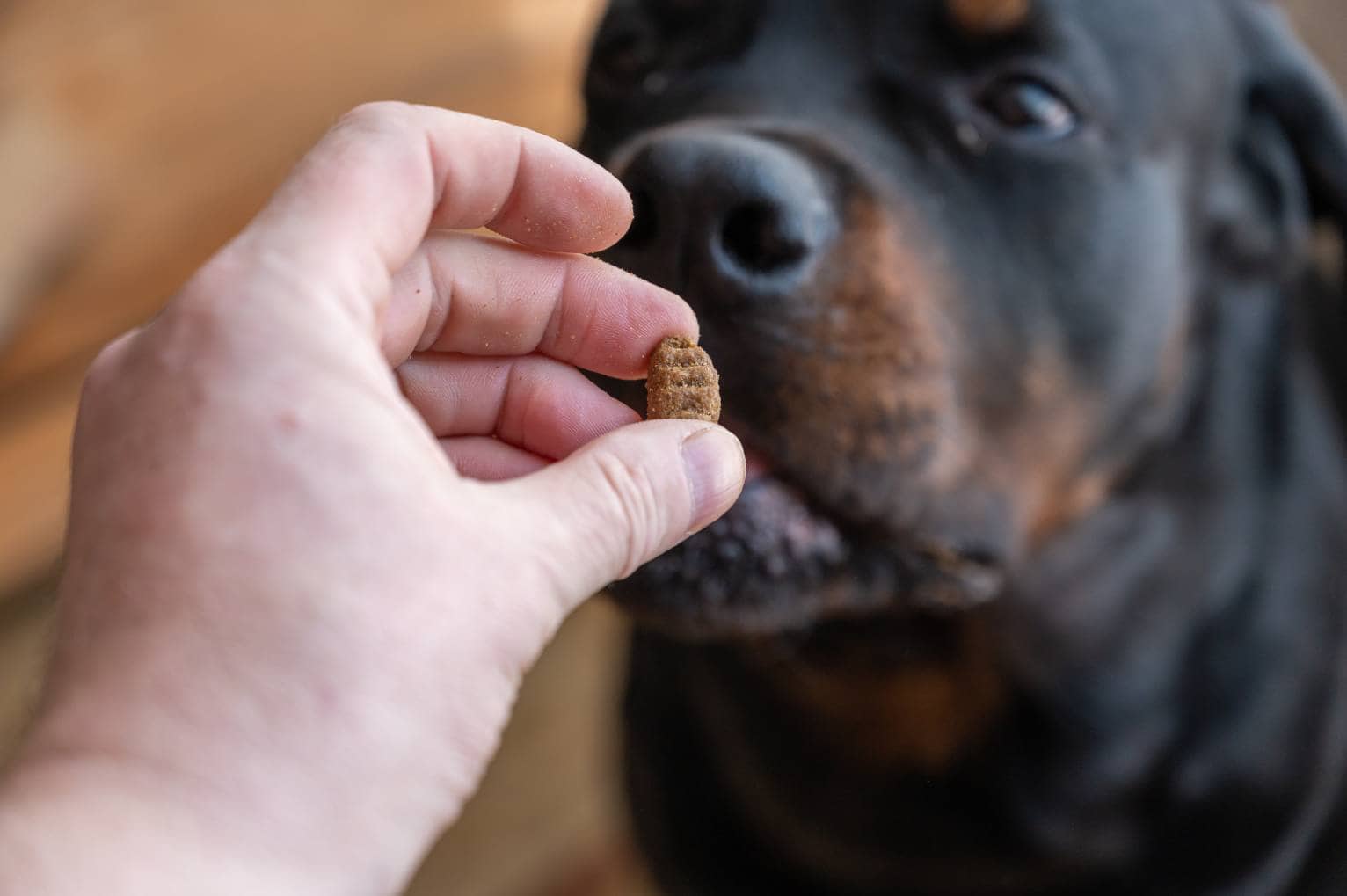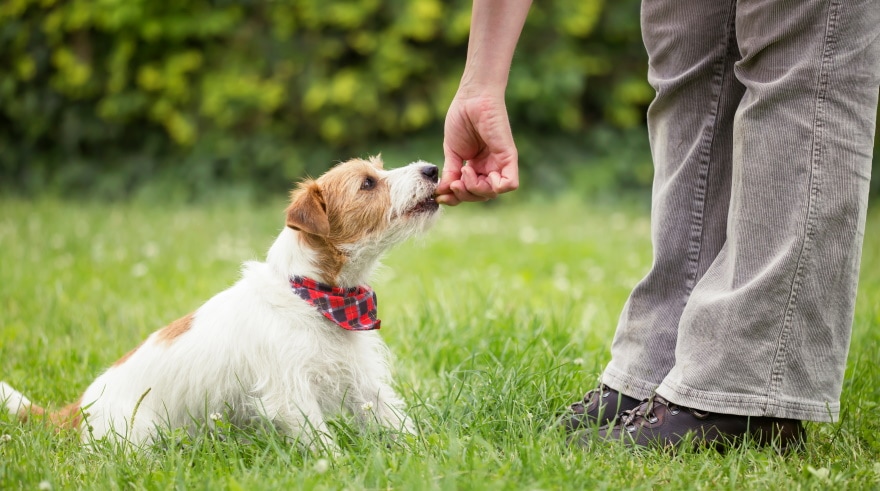Dog treats can help with training, act as a tool to get your dog to behave better, and can be used as a little tidbit to indulge your dog.
Commercial treats are available, which tend to be quite heavily processed, or you can make your own dog treats that contain healthier ingredients. But regardless of the type, it is important to remember that treats should be fed sparingly, with most experts agreeing that snacks should total no more than 10% of your dog’s daily diet.
Read on to find out exactly how many dog treats you should be feeding your dog, why you should avoid feeding more, and what you can do to prevent overfeeding.
How Many Dog Treats Should You Be Feeding?
Most experts, including the American Kennel Club, state that treats should make up less than 10% of a dog’s daily diet. But, what exactly does this mean?
In real terms, this means that you should feed 10% of your dog’s daily caloric intake as treats and no more than this. If your active Golden Retriever is eating a controlled 1,500 calories a day, then you can feed them up to 150 calories of treats.
It is important to note that this should be included in the daily caloric calculations, so if you give 100 calories of treats a day to that same Retriever, they should only be given 1,400 calories a day at mealtimes.

Caloric Intake
So, how do you know how many calories your dog is eating, or should be eating, per day?
You should be monitoring the amount of food you feed them. Check the food bag to determine how many calories are in each cup or every 100 grams of food, and work it out using that figure.
Better still, use a calorie calculator, and when in doubt, you can always consult a vet. They will tell you how many calories your dog should consume per day. They will take into account the breed and age of the dog, as well as their physical condition, daily exercise requirements, and any other factors. You may find that the 1,500 calories recommended by the dog food manufacturer is too low or way too high.
PangoVet. It’s an online service where you can <b>talk to a vet online</b> and get the personalized advice you need for your pet — all at an affordable price!
</p>
<div class="su-button-center"><a href=https://www.dogster.com/dog-nutrition/"https://pangovet.com?utm_source=dogster&utm_medium=article&utm_campaign=dog-nutrition%22 class="su-button su-button-style-default" style="color:#FFFFFF;background-color:#FF6600;border-color:#cc5200;border-radius:9px;-moz-border-radius:9px;-webkit-border-radius:9px" target="_blank" rel="nofollow"><span style="color:#FFFFFF;padding:0px 24px;font-size:18px;line-height:36px;border-color:#ff944d;border-radius:9px;-moz-border-radius:9px;-webkit-border-radius:9px;text-shadow:none;-moz-text-shadow:none;-webkit-text-shadow:none"> Click to Speak With a Vet</span></a></div></div></div>"}" data-sheets-userformat="{"2":513,"3":{"1":0},"12":0}" data-sheets-validation-definition="{"1":{"1":{"1":23,"2":[{"1":1,"3":{"1":{"1":[{"1":4,"6":1},{"1":1,"2":"="}]},"2":{"1":[{"1":2,"2":"="},{"1":3,"3":1}]},"3":"R1]S"},"4":[{"1":{"1":0,"2":20,"3":0,"4":1,"5":2236944,"6":"841046713"},"2":1}]}],"6":[{"1":{"2":{"1":2,"2":"🍎 Ate or drank"}},"2":{"1":2,"2":676776},"3":{"1":2,"2":12574966}},{"1":{"2":{"1":2,"2":"👁️ Eye issues"}},"2":{"1":2,"2":676776},"3":{"1":2,"2":12574966}},{"1":{"2":{"1":2,"2":"🤮 Vomiting"}},"2":{"1":2,"2":676776},"3":{"1":2,"2":12574966}},{"1":{"2":{"1":2,"2":"⚠️ Urinary problems"}},"2":{"1":2,"2":676776},"3":{"1":2,"2":12574966}},{"1":{"2":{"1":2,"2":"🛡️ Flea & tick"}},"2":{"1":2,"2":676776},"3":{"1":2,"2":12574966}},{"1":{"2":{"1":2,"2":"🐕 Behavior & training"}},"2":{"1":2,"2":676776},"3":{"1":2,"2":12574966}},{"1":{"2":{"1":2,"2":"❤️ Preventative wellness"}},"2":{"1":2,"2":676776},"3":{"1":2,"2":12574966}},{"1":{"2":{"1":2,"2":"🩺 Other"}},"2":{"1":2,"2":676776},"3":{"1":2,"2":12574966}}]},"2":{"1":{"1":[{"1":4,"6":0},{"1":4,"6":1},{"1":2,"3":"CONDITION_ONE_OF_RANGE","4":2},{"1":1,"2":"="}]},"3":"R0]R1]FCONDITION_ONE_OF_RANGE:2]S"},"3":[{"1":{"1":0,"2":1,"3":0,"4":1,"5":1118464},"2":0},{"1":{"1":0,"2":20,"3":0,"4":1,"5":2236944,"6":"841046713"},"2":1}]},"2":"","3":1,"4":1,"6":0}" data-sheets-validation-id="0"> If you need to speak with a vet but can’t get to one, head over to PangoVet. It’s an online service where you can talk to a vet online and get the personalized advice you need for your pet — all at an affordable price!

Once you have determined the number of calories you should feed your dog, you can assign up to 10% a day as treats and the remaining 90% as food, and calculate how much food you give them.
In the same way that food bags should contain a calorie amount, so too should any commercial treats that you offer. If you’re making your own treats, it can be more difficult, and you will have to research the ingredients by weight to determine how many calories they contain.
The exact amount of calories an individual animal needs to maintain a healthy weight is variable and influenced by many factors including genetics, age, breed, and activity level. This tool is meant to be used only as a guideline for healthy individuals and does not substitute veterinary advice
Signs You’re Feeding Too Many Treats
If you don’t intentionally monitor the treats you give your dog and the calories they contain, it is very easy to feed them too many.
1. Demanding Dog
Most dogs are creatures of habit, and they will recognize that you feed them treats at certain times or following or before certain activities. They may become increasingly demanding if they get used to being fed treats at certain times. They may also start to recognize other signs. For example, if you keep the treats in a particular drawer or cupboard, you may find that your dog becomes demanding when you open or even approach these areas.
2. Disobedient Dog
Treats are routinely used as a means of positive reinforcement training. When the dog does something that the owner wishes to encourage, they get a treat. The treat should be combined with praise and the dog gradually weaned off being given treats for positive activities. However, it is not uncommon for inexperienced pet parents to train undesired behaviors in their dogs without realizing it.
This can be especially common if you give your dog treats at the wrong moment or after a chain of behaviors that starts with an undesired one. For example, if you shush your dog for barking and then you give them a treat for stopping, your dog may recognize that barking is the first step toward getting a treat.
3. Deceptive Dog
Some owners use treats for potty training. If you give your dog a treat whenever they go outside, you may find that they demand to go out in the yard more often. They will do this under the guise that they need to pee, but they are really doing it because they want the treat that comes after.

4. Aggressive Dog
Some dogs may become very protective over food and especially over treats. You should not give any treats to a dog that becomes aggressive around them, and this is a good sign that you need the help of an animal behaviorist to rectify the situation.
How To Know You’re Feeding Them Too Many Treats
Weight Gain
If your once lean puppy has started to wobble as they trot or worse, they no longer trot because they get out of breath, this is a sure sign that you are feeding them too much. Consult a vet to determine how many calories you should be giving your dog daily, and then ensure that you only offer the recommended maximum of 10% of your dog’s caloric intake in treats.
Why It’s a Problem
Besides potential behavioral problems, feeding too many treats to your dog can cause a nutritional imbalance.
Dog food contains the protein, fats, carbohydrates, vitamins, and minerals that a dog needs. By giving them 10% of their daily diet as treats, they can still get all the required nutrients from the 90% of their diet that is good quality, complete, and balanced dog food. If you feed them more than this amount, they are getting less food with decent nutritional value. Your dog could end up with vitamin deficiencies and illnesses caused by these.
Healthy Dog Treat Examples

Just because you can feed 10% of your dog’s daily diet as treats, that doesn’t mean that you can give them anything. Certain foods, like chocolate, should be avoided altogether because they are toxic to dogs, and other human processed foods may contain very high levels of fats or salt. Some human foods can include toxic ingredients like garlic and onion. Take care of what treats you give your dog. On that note, the following are five healthy treats that you can give to your dog and that they should find thoroughly enjoyable.
1. Cooked Lean Meat
It is unlikely that you will find any treat that elicits the same desire from your dog as cooked meat. Ensure that the meat is lean, and cook it in such a way as to retain the nutrients without adding to the caloric content. Boiled chicken breast, for example, smells great to your dog and is packed with nutrients like omega-6 fatty acids.
Boiled chicken breast contains 165 calories per 100 grams.
2. Peanut Butter
Peanut butter is a common treat for dogs. It is used in food cones because it is sticky enough to hold kibble and other foods. You do need to check the ingredients before feeding this sticky treat, though.
Ensure that the peanut butter is unsalted and does not contain xylitol, which is also known as E967 or birch sugar. These artificial sweeteners can be highly toxic, but sweetener-free peanut butter is not only a good source of protein but also packed full of vitamins and minerals.
100 grams of peanut butter contains nearly 600 calories, though, so feed it sparingly.
3. Apple
Apple is juicy and smells great. It also contains natural sugar, which will appeal to your dog. At the same time, besides being a good source of vitamins, an apple’s juiciness can help keep your dog hydrated.
Cut the apple into slices, remove the seeds, and get rid of the core, which can contain trace amounts of cyanide.
A serving of 100 grams of apple only contains 50 calories, which is preferable to peanut butter.
4. Carrot
Like apples, carrots are great natural treat options for your dog. They contain carotenoids, potassium, fiber, and a host of other vitamins and minerals.
Carrots can be fed raw, or they can even be frozen and fed as edible chew toys (under your supervision). Their natural sweetness makes them appealing to dogs.
They contain just 41 calories per 100 grams.
5. Pear
This sweet, natural food is often overlooked as a dog treat. But it is packed with fiber, vitamins, and antioxidants.
You need to remove the seeds and core, but eating this fruit can help improve your dog’s immune system and digestive system.
A serving of 100 grams of pear contains approximately 60 calories, so it is not too high in calories either.

How Many Dog Treats Is Too Many?
Dog treats can be a beneficial addition to a dog owner’s arsenal. They are useful in training and help encourage your dog to do what you want them to. However, this kind of power should be wielded responsibly, and you will need to be sparing in your application of dog treats.
A maximum of 10% of your dog’s daily diet can be given as treats, but you still need to ensure that the treats are reasonably healthy and will not cause damage to your dog.
You may also be interested in:
- 8 Best Dog Treats at PetSmart – Reviews & Top Picks
- What is a Starbucks Puppuccino? And How Can I Order It?
Featured Image Credit: pakornkrit, Shutterstock













